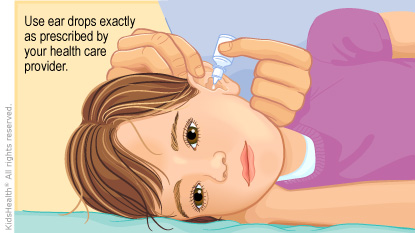Otitis Externa: How to Care for Your Child
Otitis externa is swelling and irritation of the ear canal. It's usually caused by an infection with bacteria (a type of germ). Otitis externa is treated with antibiotic ear drops. With treatment, most kids start to feel better within a few days.


Medicines
-
Give any medicines exactly as prescribed by the health care provider, such as antibiotic ear drops and/or oral (by mouth) medicines.
-
Even if symptoms are gone, it's important to give the medicines for the full number of days prescribed. Otherwise, the otitis externa could come back.
Using Ear Drops
-
To use the drops:
-
Wash your hands before and after using the ear drops.
-
Have your child lie on his or her side with the ear that is getting the medicine facing up.
-
If there is fluid coming from the ear canal, remove it with a clean tissue. Clean only the outside of the ear. Do not put anything inside the ear canal to clean it.
-
Gently pull the outer ear outward and upward or downward until you can see clearly into the ear canal. Steady the hand holding the medicine dropper by placing your wrist on your child's cheek or head.
-
Put the correct number of drops into the ear canal without touching the dropper to any part of the ear.
-
Have your child stay on his or her side for 5 minutes and gently rub the skin in front of the ear to help the ear drops flow inside the ear canal.
-
Rinse the tip of the dropper with clean water and put the cap on the medicine bottle right away.
If Your Child Has Pain
Caring for Your Child's Ears
-
Your child should not get the ears wet until all of the medicine is finished and the pain is gone. To keep the ears dry:
-
While bathing or showering, your child can place a cotton ball coated with petroleum jelly (such as Vaseline® or a store brand) or wear a shower cap over the ears.
-
Have your child avoid swimming or other water activities where water can get into the ears.
-
Your child can use ear buds when all of the medicine is finished and the pain is gone.

-
Your child's pain gets worse.
-
Blood or pus is draining from the ear.
-
Your child gets a fever.
-
There is redness, swelling, or warmth of the ear or the area around it.

Your child:
-
has increasing or severe pain
-
looks sicker
-
develops new symptoms like trouble swallowing, weakness of the face, or a hoarse voice

What are the signs of otitis externa? Kids with otitis externa usually have pain and itching of the ear canal. They can have a plugged-up feeling in the ear from the swelling and might feel that they can't hear as well as usual. There also can be discharge from the ear.
What causes otitis externa? Otitis externa is usually caused by an infection from bacteria. Things that can break down the skin in the ear canal and allow bacteria to grow include:
-
swimming a lot (otitis externa in someone who swims a lot is called "swimmer's ear")
-
scratching the ear canal with a fingernail or cotton swab
-
hearing aids, headphones, and earplugs
-
allergies
-
some skin conditions
How can I prevent my child from getting otitis externa again? To prevent another otitis externa:
-
Do not put cotton-tipped swabs or any other objects into the ears.
-
Only let your child swim in pools and hot tubs that are checked regularly for bacteria and kept clean.
-
Have your child avoid swimming in rivers, lakes, or ponds with high bacteria levels. Check for posted signs about the level of bacteria and if it's safe to swim.
-
After swimming or bathing:
-
Have your child tip the head to the side to let the water drain out.
-
Dry the outer ear with a towel.
-
Use a hair dryer on the lowest heat setting, held at least 12 inches from the ear, to help dry the ear canal.
-
If your health care provider recommends it, have your child:
-
Use earplugs and a bathing cap for swimming.
-
Use over-the-counter ear drops such as Swim-EAR®, Auro DRI®, or a store brand after swimming.